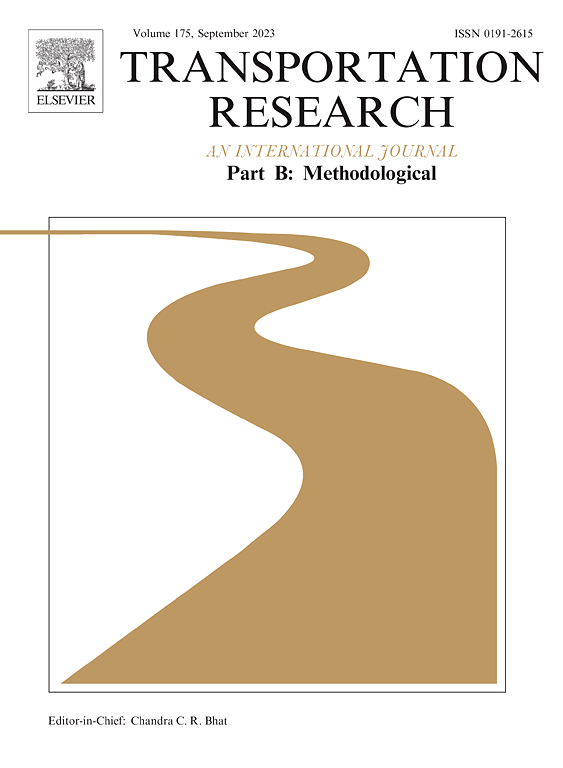Bridging the gap between micro-economics and micro-mobility: A two-dimensional risk-based microscopic model of pedestrians’ and bicyclists’ operational behaviors
IF 5.8
1区 工程技术
Q1 ECONOMICS
引用次数: 0
Abstract
Due to the inherent safety concerns associated with traffic movement in unconstrained two-dimensional settings, it is important that pedestrians’ and other modes’ movements such as bicyclists are modeled as a risk-taking stochastic dynamic process that may lead to errors and thus contacts and collisions. Among the existing models that may capture risk-taking behaviors are: 1) the social force models (through the interplay of the repulsion and the attraction force parameters); 2) and the discrete-choice models (through the rationality or the bounded rationality paradigm while weighing different alternatives). Given that the social force models may not readily capture the contact/collision dynamics through the Newtonian force framework, decision-making theories are hypothesized as a feasible approach to formulate a new model that can account for cognitive and behavioral dimensions such as uncertainty and risk. However, instead of relying on the bounded rationality theory, in this paper, a generalized Prospect Theory based microsimulation model is proposed. The model relies on the micro-economics Prospect Theory paradigm where pedestrians or bicyclists (i.e., micro-mobility users) evaluate their speed and directional alternatives while considering the possibility of colliding with other obstacles/users. A numerical analysis on the main model parameters is presented. The model is then calibrated and validated using two real-world data sets with trajectories recorded in naturalistic settings. With the calibrated parameters studied, simulation exercises and sensitivity analysis are conducted to recreate bottlenecks and lane formations in different conditions. The findings show that the proposed model's parameters reflect the risk-taking tendencies of different roadway users in mixed right-of-way's environments while showing realistic microscopic and macroscopic traffic flow characteristics.
缩小微观经济学与微观交通之间的差距:基于风险的二维行人和骑自行车者操作行为微观模型
由于在无约束的二维环境中,交通移动存在固有的安全问题,因此必须将行人和自行车等其他交通方式的移动建模为一个冒险的随机动态过程,该过程可能会导致错误,进而发生接触和碰撞。可捕捉冒险行为的现有模型包括1) 社会力模型(通过排斥力和吸引力参数的相互作用);2) 离散选择模型(通过理性或有界理性范式权衡不同的选择)。鉴于社会力模型可能无法通过牛顿力框架轻易捕捉接触/碰撞动态,决策理论被假定为制定新模型的可行方法,该模型可考虑认知和行为层面,如不确定性和风险。然而,本文没有依赖有界理性理论,而是提出了一个基于前景理论的广义微观模拟模型。该模型依赖于微观经济学的前景理论范式,行人或骑自行车的人(即微观移动用户)在考虑与其他障碍物/用户发生碰撞的可能性的同时,对其速度和方向进行评估。本文对模型的主要参数进行了数值分析。然后,利用在自然环境中记录轨迹的两个真实世界数据集对该模型进行了校准和验证。在研究了校准参数后,进行了模拟练习和敏感性分析,以重现不同条件下的瓶颈和车道形式。研究结果表明,建议模型的参数反映了混合路权环境下不同道路使用者的冒险倾向,同时显示了真实的微观和宏观交通流特征。
本文章由计算机程序翻译,如有差异,请以英文原文为准。
求助全文
约1分钟内获得全文
求助全文
来源期刊
CiteScore
12.40
自引率
8.80%
发文量
143
审稿时长
14.1 weeks
期刊介绍:
Transportation Research: Part B publishes papers on all methodological aspects of the subject, particularly those that require mathematical analysis. The general theme of the journal is the development and solution of problems that are adequately motivated to deal with important aspects of the design and/or analysis of transportation systems. Areas covered include: traffic flow; design and analysis of transportation networks; control and scheduling; optimization; queuing theory; logistics; supply chains; development and application of statistical, econometric and mathematical models to address transportation problems; cost models; pricing and/or investment; traveler or shipper behavior; cost-benefit methodologies.

 求助内容:
求助内容: 应助结果提醒方式:
应助结果提醒方式:


